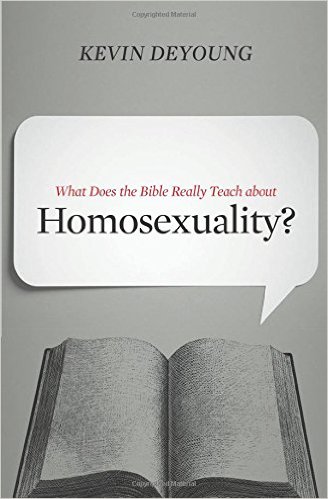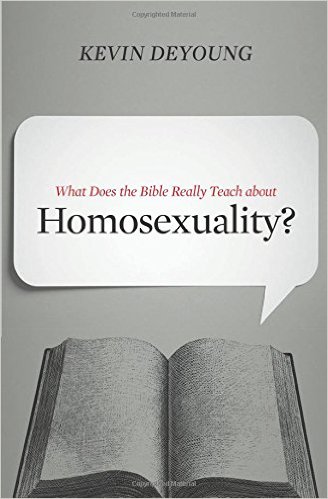What Does the Bible Really Teach about Homosexuality?

A Denver Journal Book Review by Denver Seminary student Chad E. Graham

Kevin DeYoung, What Does the Bible Really Teach about Homosexuality? Wheaton, IL: Crossway, 2015. 153 pp. Paperback, $8.60. ISBN 978-1433549373.
Kevin DeYoung is Senior Pastor at University Reformed Church in East Lansing, Michigan. In only 150 pages, this book seeks to do justice to the complex exegetical backdrop of the few biblical passages on homosexual activity. The title of the book hints at the assumption that there is growing confusion surrounding what the Bible actually teaches about homosexuality. DeYoung manages to keep the page count low by stating clearly in the introduction that “this is a Christian book” and that it “assumes a fair amount of common ground” with the audience. Therefore, the book does not address all Christian and non-Christian perspectives; its aim, rather, is to present a position that treats “the Bible as God’s Word, as an inspired, authoritative, unbreakable, fully trustworthy account of divine revelation.”
The book covers passages in Genesis 1–2; 19; Leviticus 18; 20; Romans 1; 1 Corinthians 6; and 1 Timothy 1. For a more detailed exegetical treatment of the same passages, the reader is encouraged to consult Robert A. J. Gagnon’s tome, The Bible and Homosexual Practice: Text and Hermeneutics, which is referenced frequently in DeYoung’s book. DeYoung does an excellent job of summarizing the scholarly literature, making it accessible to lay leaders and popular audiences. The real value of his book is in Part 2, “Answering Objections,” which confronts common objections to the majority evangelical interpretation of the passages above.
The objections are approached with a pastoral spirit that is both firm and fair to possible objectors. If more evangelical pastors would learn to address the deep intellectual and existential questions of their congregations in this very way, we would be twice as effective in turning hearts and minds toward the truth about homosexuality and gender identity. The objections engaged represent a wide spectrum of approaches to the issue, ranging from objective queries like “The Bible hardly ever mentions homosexuality”—a claim that is quantitative and, on the face of it, factual—to objections like “It’s not fair” and “You’re on the wrong side of history” that engage emotions and subjective assessments. Both types of objections warrant a thoughtful response. Christians will increasingly encounter both types of objections as American culture becomes more comfortable with non-traditional sexual relationships and fluid gender identities.
The objection addressed in chapter 12, “The God I Worship is the God of Love,” is perhaps the most prolific objection within the church as to what the Bible teaches about homosexuality. DeYoung aptly evokes the simplicity of God and the nature of his being to describe how this objection is truly a non-starter for the Christian. He writes, “We often hear people say, ‘God may have justice or wrath, but the very essence of is love.’ The implication is that love is more central to the nature of God, more true to his real identity, than other less essential attributes” (122). God’s simplicity does not allow for composite “parts” and it resolves all struggles toward prioritizing God’s attributes. There is no priority structure to his attributes. God is love and, at the same time, omniscient, just, merciful, etc. God does not choose one attribute over another; he is not blind to justice when he extends grace or mercy. Love loses its meaning apart from justice, and love that violates justice is no love at all. God’s simplicity is still relevant today; we should be reading Aquinas and the scholastics to help us understand it and preach it for the edification of the body. It is our strongest defense against false notions of love and God’s misuse of love to cover what he clearly calls sin.
It is worth your time to read the three appendices and take notice of the annotated bibliography. The appendices discuss same-sex marriage, same-sex attraction, and how the Church should interact with others on the topic. Pastors should pay special attention to the list on pages 148-150, which describes some helpful ways to speak to different audiences. As an example, DeYoung urges us, “If we are speaking to cultural elites who despise us and our beliefs, we want to be bold and courageous”; on the other hand, “If we are speaking to strugglers who fight against same-sex attraction, we want to be patient and sympathetic.” His list of “ten commitments” for Christians and churches should be read aloud at elder meetings to help create a culture familiar with the arguments, the struggles, and the hope surrounding homosexuality and the Bible.
What Does the Bible Really Teach about Homosexuality? is a well-written, well-researched commentary on one of the seminal issues of our age. Centuries from now, theologians, philosophers, and historians will look back at this period and see an explosion of treatises and tomes dedicated to discovering the truth about gender, sexuality, marriage, family, and other areas of life effected by such subjects. This book has the potential to be a potent resource for equipping laity and church leaders to think wisely about what the Bible teaches concerning homosexuality—and what we should do in response as faithful witnesses to the living Word of God.
Chad E. Graham
Denver Seminary
August 2016
